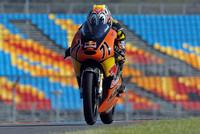Good Road Racing vibrations ahead of Shanghai In Istanbul, Red Bull KTM 125cc rider Tomoyoshi Koyama scored his first podium finish of the year – and is now glowing with confidence for the coming world championship road races. Koyama clocked best top speed at the Spanish Grand Prix in Jerez and would have also out-paced his competitors at the next round in Turkey had his crew not anticipated strong headwinds. The gearing was therefore a touch short, giving the best Aprilia bikes a slight edge on that occasion. For the next round in China, with a 1.3 kilometre long main straight on the impressive Shanghai circuit, it’s once again safe to assume a slight speed advantage for Koyama. The sheer top-end power of his Red Bull KTM 125 FRR with reed valve intake can match the power output of the competition with their rotary valve intakes. And the 24-year-old, diminutive, 155 cm tall Japanese rider can tuck in behind the KTM fairing very easily to transform himself into an integral part of the ideal, streamlined shape that was developed in extensive wind tunnel testing. But superior top speed is not the key to Koyama’s success. As in the larger Grand Prix categories, it’s all about handling and rideability. After years on Honda and Malaguti, Koyama only joined KTM at the beginning of this season and needed just two races to fully adapt to his new machine. “The bike is very good. Especially the chassis is getting better all the time,” beams Koyama, glowing with confidence. At the first race in Qatar, Koyama experienced a small problem with the idle system of his carburettor. This upset the smooth power delivery of his bike and caused some chassis chattering, but the problem has long been identified and corrected by Technical Director and KTM road racing constructor Harald Bartol. “Koyama has used the revised version of this carburettor very successfully in Istanbul. For the next race in China, the new carburettor will also be available for his team-mates Randy Krummenacher and Steve Bonsey,” explains Harald Bartol. KTM’s 125 FRR features a unique and exclusive fuel injection system that is not designed to replace, but instead to work in conjunction with the carburettor. It allows fine tuning of the fuel supply and lubrication under extreme circumstances — such as over-revving whilst back-shifting with closed throttle — and it does it with unparalleled precision. The engine can be set up to run lean at any rev range and under any load, without the dangers of piston seizures. With the right set-up, the KTM engine is not only very fast, but also strong in acceleration, with smooth, easily controllable power delivery. “Riders aren’t robots. And if the power kicks in too aggressively, they will feel a risk factor at the exit of each turn. It’s like shying at an abyss. They will open the throttle later and more cautiously, and inevitably lose time,” explains the Red Bull KTM 125 Team. “Therefore, we won’t stop working on our carburetion until our engines run like electric motors, with a very linear and predictable power curve.” Suspension settings are obviously another big factor for the rider’s well-being and comfort. In Koyama’s case, the set-up of the front fork and rear shock is especially crucial. With just 55 kg of body weight, or 68 kg with full riding gear, Koyama doesn’t create as much weight transfer on the bike as other riders and he needs more overall height of the bike and softer suspension settings to compensate. If the right feedback and feeling from the bike still aren’t quite there after working on engine and chassis settings, then it’s all down to the Dunlop tyres. The choice is usually down to just two different compounds on the front and the rear, not much at all in comparison to the varieties available in the MotoGP category. But still, there is the choice of air pressure. A front tyre with a softer compound might just develop the right stability under brakes with a little more air pressure. A harder compound might, in return, give the rider just this little bit extra feel if the air pressure is lowered. Sometimes it’s a minute adjustment that can make all the difference. And sometimes, there is no adjustment necessary at all. “Tomoyoshi likes the bike more and more, but there is another, very simple reason: He is getting used to it. The more he rides our KTM, the more he learns about the way it reacts and where the limits are. And the more he knows about it, the quicker he will go,” says the Red Bull KTM 125 Team. A first success in Turkey, growing confidence for the bike and good vibrations in the team: This all translates into great perspectives for the coming races — no matter how long the straights might be.
KTM Talks About Top Speed And Carburetion In Its Preview Of The Grand Prix Of China
KTM Talks About Top Speed And Carburetion In Its Preview Of The Grand Prix Of China
© 2007, Roadracing World Publishing, Inc.






